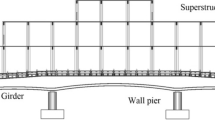Abstract
Shear effects are often a very important issue on the seismic behaviour of piers, particularly for hollow section bridge piers. In fact, for this type of piers the cyclic response is similar to that of a structural wall in which both the transverse reinforcement ratio and the detailing can play an important role on its performance, even likely to be determinant in terms of the failure mechanism. On the other hand, codes and design guidelines are usually very conservative concerning shear capacity in order to avoid any shear failure mechanism likely to trigger well known catastrophic consequences. Therefore, research studies on this topic are still needed for a better understanding of pier cyclic shear response and also for improvement of the performance under seismic actions. Pursuing this general objective, this paper partially reports on an experimental/numerical campaign carried out on 1:4 reduced scale bridge piers in order to highlight and investigate shear-type problems. Within the scope of this paper, two specimens types were selected having equal rectangular hollow section (900 × 450 mm2, 75 mm thick) but different transverse reinforcement detailing, namely one with a single stirrup per wall (representative of typical bridge construction without seismic design requirements) and another with multiple stirrups, according to Eurocode 8 provisions. Numerical simulations of the experimental results were also conducted aiming at contributing for complete and consistent interpretations of experimental results. Detailed modelling was performed allowing for realistic simulations of the non linear behaviour, particularly suitable when a significant shear component is involved. Therefore, the numerical strategy was based on a detailed 3D FEM discretization using a two-scalar variable damage model for the concrete constitutive law and a suitable cyclic behaviour law for steel bars represented by truss elements. Results have shown that shear deformation and failure modes are well simulated, while providing detailed insight concerning concrete damage pattern and distribution of yielding on the transverse and longitudinal reinforcement.
Similar content being viewed by others
References
Arêde A (1997) Seismic assessment of reinforced concrete frame structures with a new flexibility based element. PhD Thesis, FEUP, Porto. http://ncrep.fe.up.pt/web/artigos/AArede_PhD_Thesis_Public.pdf
Calvi GM, Pavese A, Rasulo A, Bolognini D (2005) Experimental and numerical studies on the seismic response of R.C. hollow bridge piers. Bull Earthquake Eng 3(3): 267–297. doi:10.1007/s10518-005-2240-0
CEA (2003) Pasquet P. Manuel d’utilisation de Cast3m, Commissariat à l’Énergie Atomique
CEB (1996) Costa and costa model—RC frames under earthquake loading, Comité Euro-International du Béton, Bulletin n°231
Costa C, Pegon P, Arêde A, Castro J (2005) Implementation of the damage model in tension and compression with plasticity in Cast3m. Report EUR, ISPC, CEC, JRC, Ispra (VA), Itália
Delgado P (2008) Avaliação da Segurança Estrutural em Pontes. PhD Thesis, FEUP, Porto (in Portuguese)
Delgado P, Rocha P, Pedrosa J, Arêde A, Vila Pouca N, Santos M et al (2007) Retrofitting of bridge hollow piers with CFRP. In: Paper presented at the thematic conference on computational methods in structural dynamics and earthquake engineering, Crete, Greece, 13–16 June 2007
Faria R, Oliver J, Cervera M (1998) A strain based plastic viscous damage model for massive concrete structures. Int J Solids Struct 35(14): 1533–1558. doi:10.1016/S0020-7683(97)00119-4
Faria R, Vila Pouca N, Delgado R (2004) Simulation of the cyclic behaviour of R/C rectangular hollow section bridge piers via a detailed numerical model. J Earthquake Eng 8(5): 725–748. doi:10.1142/S1363246904001547
Giuffrè A, Pinto P (1970) Il comportamento del cemento armato per sollecitazione ciclice di forte intensitá. Giornale del Genio Civile
Guedes J (1997) Seismic behaviour of reinforced concrete bridges. Modelling, numerical analysis and experimental assessment. PhD Thesis, FEUP, Porto. http://ncrep.fe.up.pt/web/artigos/JGuedes_PhD_Thesis_Public.pdf
Pavese A, Bolognini D, Peloso S (2004) FRP seismic retrofit of RC square hollow section bridge piers. J Earthquake Eng 8(1 SPEC ISS): 225–250
Pinto AV, Molina J, Tsionis G (2003) Cyclic tests on large-scale models of existing bridge piers with rectangular hollow cross-section. Earthquake Eng Struct Dyn 32(13): 1995–2012. doi:10.1002/eqe.311
SeismoStruct (2002) A computer program for static and dynamic nonlinear analysis of framed structures. http://www.seismosoft.com
Taucer F, Spacone E, Filippou FC (1991) A fibre beam-column element for response analysis of RC structures. Report EERC 91–17, Earthquake Engineering Research Center, University of Califormia, Berkley
Vecchio FJ, Collins MP (1988) Predicting the response of reinforced-concrete beams subjected to shear using modified compression field-theory. ACI Struct J 85(3): 258–268
Yeh YK, Mo YL, Yang CY (2002) Full-scale tests on rectangular hollow bridge piers. Mater Struct 34(246): 117–125
Author information
Authors and Affiliations
Corresponding author
Rights and permissions
About this article
Cite this article
Delgado, R., Delgado, P., Vila Pouca, N. et al. Shear effects on hollow section piers under seismic actions: experimental and numerical analysis. Bull Earthquake Eng 7, 377–389 (2009). https://doi.org/10.1007/s10518-008-9098-x
Received:
Accepted:
Published:
Issue Date:
DOI: https://doi.org/10.1007/s10518-008-9098-x




